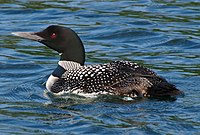
Photo from wikipedia
Quantifying how contaminants change across life cycles of species that undergo metamorphosis is critical to assessing organismal risk, particularly for consumers. Pond-breeding amphibians can dominate aquatic animal biomass as larvae… Click to show full abstract
Quantifying how contaminants change across life cycles of species that undergo metamorphosis is critical to assessing organismal risk, particularly for consumers. Pond-breeding amphibians can dominate aquatic animal biomass as larvae and are terrestrial prey as juveniles and adults. Thus, amphibians can be vectors of mercury exposure in both aquatic and terrestrial food webs. However, it is still unclear how mercury concentrations are affected by exogenous (e.g., habitat or diet) vs endogenous factors (e.g., catabolism during hibernation) as amphibians undergo large diet shifts and periods of fasting during ontogeny. We measured total mercury (THg), methylmercury (MeHg), and isotopic compositions (δ 13C, δ15N) in boreal chorus frogs (Pseudacris maculata) across five life stages in two Colorado (USA) metapopulations. We found large differences in concentrations and percent MeHg (of THg) among life stages. Frog MeHg concentrations peaked during metamorphosis and hibernation coinciding with the most energetically demanding life cycle stages. Indeed, life history transitions involving periods of fasting coupled with high metabolic demands led to large increases in mercury concentrations. The endogenous processes of metamorphosis and hibernation resulted in MeHg bioamplification, thus decoupling it from the light isotopic proxies of diet and trophic position. These step changes are not often considered in conventional expectations of how MeHg concentrations within organisms are assessed.
Journal Title: Environmental science & technology
Year Published: 2023
Link to full text (if available)
Share on Social Media: Sign Up to like & get
recommendations!